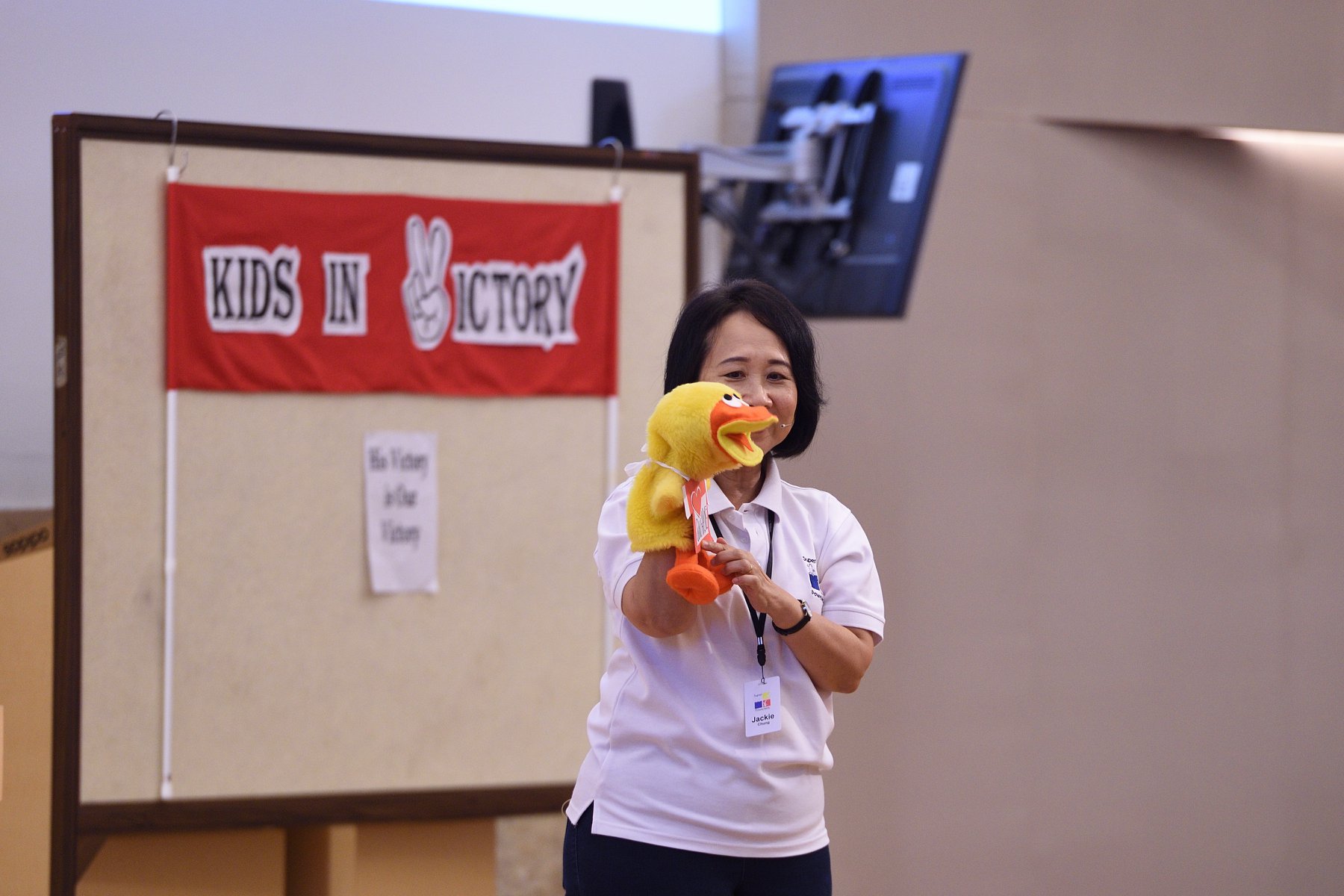7 Do’s and don’ts when sharing the Gospel with children
by Christine Leow // April 1, 2022, 4:24 pm

Jacqueline Chung has some 30 years of experience both in the children's ministry and in pre-school education, and has shared the Gospel with countless children. Photo courtesy of Jacqueline Chung.
In heaven, will we be able to recognise one another?
Will my parents be married?
Will my puppy be there?
Jacqueline Chung has some three decades of experience sharing the Gospel with children as the Academic Director of the Anglican Preschool Services and the pioneer of St James Church children’s ministry Super PowerKids.
She shared that, with children, the topic of heaven always sparks plenty of interests and questions.
Salt&Light spoke to Jacqueline as well as Esther Foong from The Treasure Box SG about how the Gospel can be presented to children as young as four years old in a way they can understand.
Here are some do’s and don’ts.
When sharing the Gospel with children, do …
1. Use clear, age-appropriate words they can understand
“The younger the child, the less you talk unless they ask you questions. Don’t keep offering them the facts.
“The key points are the same as for adults, just in simpler words.”
“They will have the opportunity to develop an understanding over time. They learn as they grow,” said Jacqueline.
“But that doesn’t mean we avoid answering either. We are waiting for the developmental age and stage to happen, waiting for the appropriate time, waiting for them to ask.”
Esther agreed: “Engage the child at their level of understanding and expression.”

Esther and Elvin Foong from The Treasure Box SG provide training and resource to parents to help them lead their families in discovering and experiencing God together. Photo courtesy of the Foongs.
Stick to the key ideas:
- God loves them and wants a relationship with them.
- Sin separated them from God’s love.
- Jesus died for those sins.
- Now they can have a relationship with God if they are sorry for their sins, confess and repent of them, and accept Jesus as their Saviour.
- Extend the invitation: “Would you like to accept Jesus as your Saviour?”
Added Jacqueline: “The key points are the same as for adults – know God loves them and because He loves them, He has found a way for us to return to Him – just in simpler words.”
With children, it is not so much about engaging the mind but about igniting the heart.
2. Emphasise God’s love above all else
Although some of the ideas may be abstract, the central idea of God’s love is something children can grasp.
“Go easy on the hell part for very young children … Even heaven is a difficult concept.”
This is because even very young children have seen love in action and most have been told they are loved.
So talking about God’s love, which is central to the Gospel message, makes the Gospel more accessible and relatable.
“Go easy on the hell part for very young children,” suggested Jacqueline. “It’s hard for children to understand. Even heaven is a difficult concept.”
3. Repeat the message often
Children need time to grow into their understanding of the redemptive love of God and also to grow into their decision of accepting the Gospel.
“Sharing the Gospel with children is never a one-time thing.”
So, with children, it is good to share the Gospel at every opportunity. At Super PowerKids, the Gospel message is woven into every lesson.
“We have a year-round programme where we cover various topics like faith and understanding the word of God, and the Gospel is a large part of all of it. There is a constant reference.”
Over the years, Jacqueline has noticed that some children may raise their hands during altar calls to receive Jesus as their Saviour repeatedly. This is part of their growth and learning process.

Jacqueline believes that the Gospel message bears repeating with children who need time to fully grasp the truth. Photo courtesy of Jacqueline Chung.
“The little ones tend to receive Christ multiple times because it doesn’t all quite connect yet.
“Children are growing and thinking about their faith.”
“As they grow older, they stop coming up for the altar call. That’s when they know (for sure),” said Jacqueline.
“So, sharing the Gospel with children is never a one-time thing.
“It’s an ongoing motion of the truth of God’s Word because with every year that they develop, they are growing and thinking about their faith.”
4. Give time and space for children to respond
“Our ultimate goal is for the child to truly come to faith on their own terms, and not just do it because a parent or an authority figure says they should,” said Esther.
“They may come back to you the following day, the following week, because somehow something clicked, or an encounter or God moment in the week helped them understand and relate to what you were sharing that day.”
Repetition rather than pressure is the key.
5. Respond to their questions
When they do come back with questions because “something clicked”, answer their questions simply.
When answering the many questions about heaven that she gets, Jacqueline is honest.
“I tell them, ‘We only know what the Bible describes. Apart from that, we don’t know but it will be good things. It will be nothing like we can conceive of.’”
6. Use visuals
Children have difficulty with abstract thought, which develops only around the age of 12. Using visual aids helps.
“We literally use a hammer to knock the nails into the wooden board. Then, we facilitate the conversation.”
Jacqueline composed a Gospel rap 18 years ago for that very purpose. The song is performed with each child wearing a cap of a different colour. Kids are taught to sing the rap as a way of hearing the Gospel.
GOOD NEWS RAP
Listen everybody to the Good News Rap
Let’s all move together, let’s rap and clap
In the beginning when it all began
God was our friend that was His plan
Black is sin our hearts turned bad
Sin came in and made God sad
Red is blood that Jesus shed
To take my sin that’s why He bled
White is pure, I have no more sin
My heart is clean ‘cos Jesus lives within
Green is grow in every way
I’ll read my Bible and pray each day
Blue is share to all we know
Jesus saves let’s tell them so
Yellow is heaven, where we’ll stay
Living with Jesus, forever – Hooray!
Now you know that God loves you
This is what you need to do
Just let Him in to take control
Act in faith, give your heart and soul – YES!
The Treasure Box SG has their own materials like Why is Good Friday Good? which uses talks about the good news of salvation in Jesus using the very question children have asked. The book is illustrated by the Foongs’ own children, which appeals to other children.

Esther and Elvin sharing the Gospel message. Photo courtesy of the Foongs.
They are in the process of developing a Salvation kit for children that caring adults can use to share the Good News.
Other ways to visualise the Gospel include The Gospel Colours in which six colours are used to represent different aspects of the Gospel message. The Wordless Book works on the same idea of using colours and is great for very young children who have yet to learn to read.
For something interactive, The Treasure Box SG has a Good Friday Activity Kit.

The Good Friday Activity kit gives children actions to make as they listen to the Gospel message. Photo courtesy of the Foongs.
“We literally use a hammer to knock the nails into the wooden board. Then, we facilitate the conversation as the children listen to the piercing sounds and feel the sharp nails,” explained Esther.
“There is a red yarn they use to coil around the nail, like putting their sins onto the cross. Finally, the children coil on the bright yellow yarn representing Jesus’ holiness and redemptive powers which cover our sins.”
Another interactive way of sharing the Gospel is the Gospel Airplane where a paper airplane is used to share the Gospel. The children can fold a paper airplane of their own as they listen, giving them a task which helps them concentrate better.
7. Model your faith
As important as the message is, the person sharing the message is just as important.
Esther encouraged adults to “give children good reason to believe in the power of the Gospel”.
“Why would they want to believe in a loving God, when that same love is not being exhibited by the one sharing the Gospel?”
When sharing the Gospel with children, don’t …
1. Use “Christian-ese” terms that are too abstract
Words like “salvation”, “redemption” and “deliverance” may be central to the Gospel message but they are terms that make no sense to the child, said Esther.
More relatable words like “save” and “forgive” can be used instead.
2. Underestimate a child’s ability to understand the Gospel
“Children are far more intelligent than we give them credit for. Remember: Simple doesn’t mean simplistic.
“The Gospel has the power to save and transform every life, even young ones,” said Esther.
So, while difficult terms should be avoided, the key concepts should not be watered down.
3. Go into too much detail
Neither should there be too many details. With children, repetition reinforces. Say it often rather than squeeze everything into one session.
4. Reduce the Gospel to a fairy tale
“We don’t want children growing up thinking that the Bible is just a book of fables and good values. God’s Word is applicable in our daily living and God is real and He is with us,” said Esther.
Relatable words, relatable stories including your own personal encounters, can make the Gospel truth come alive.
5. Scare children into making a decision
Don’t threaten them with hell, intimidate them with your authority, or pressure them into making a decision.
6. Make assumptions about a child’s decision to accept Jesus
Said Esther: “Don’t say, ‘They don’t understand, they make the same decision every week, there’s no change in their behaviour, so they don’t mean it.’
“Spend time to journey with them.”
“Treat every decision that the child makes with the utmost seriousness and joy.
“To you, it may seem flippant. But to the child, every time they choose Jesus is a big deal.”
At Super PowerKids, every altar call is followed up with a smaller group discussion where the children are grouped according to their age.
In that group, teachers can ask questions to clarify the children’s intention and the children can ask questions.
7. Assume that someone else will follow up and disciple the child
“Get your hands dirty and do it yourself. Call them in the week, share with them some resources, spend time to journey with them,” encouraged Esther.
For those who respond to the altar call at Super PowerKids, every week that they are in church is treated as a follow-up session, said Jacqueline.
RELATED STORIES:
We are an independent, non-profit organisation that relies on the generosity of our readers, such as yourself, to continue serving the kingdom. Every dollar donated goes directly back into our editorial coverage.
Would you consider partnering with us in our kingdom work by supporting us financially, either as a one-off donation, or a recurring pledge?
Support Salt&Light


